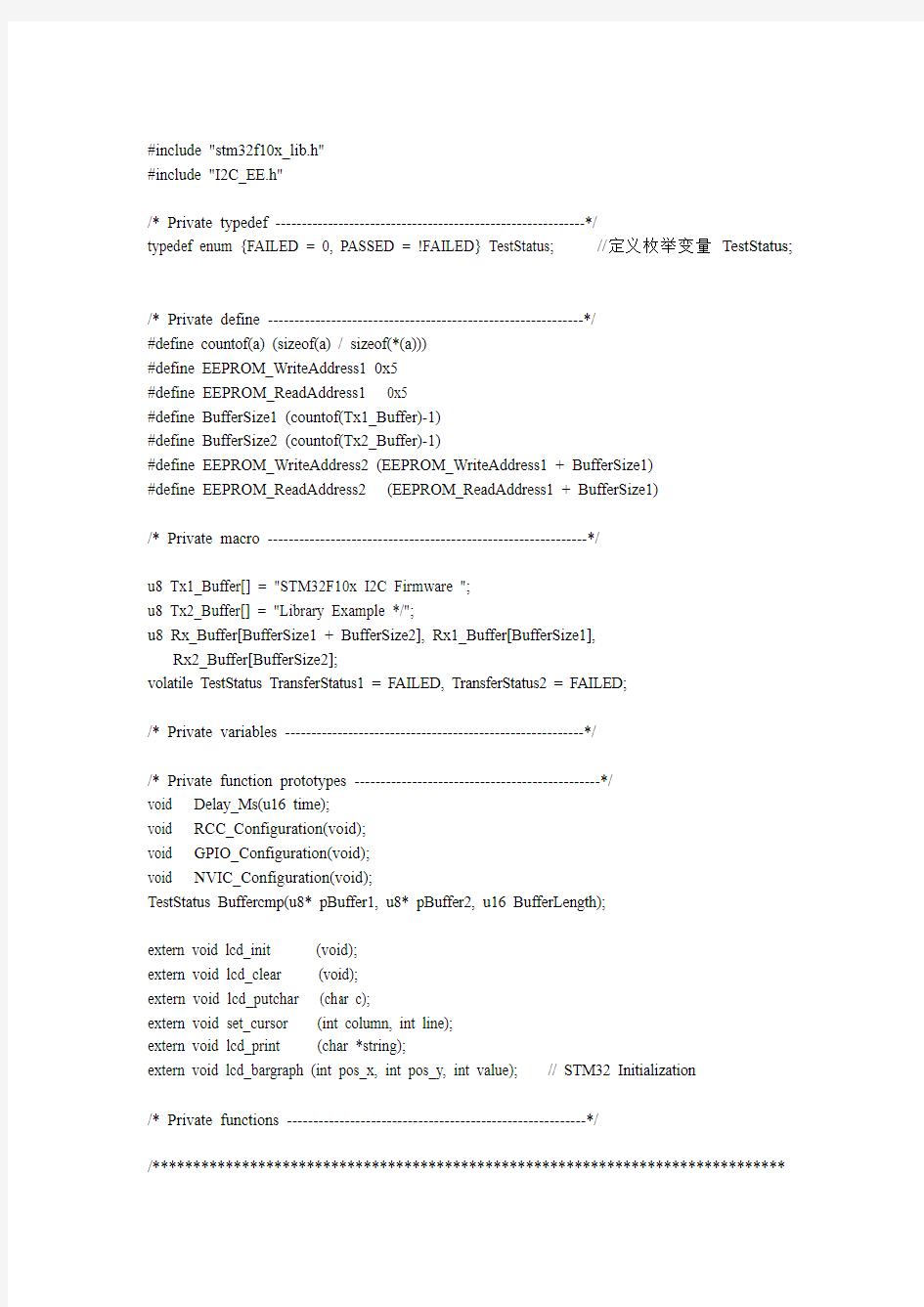

#include "stm32f10x_lib.h"
#include "I2C_EE.h"
/* Private typedef -----------------------------------------------------------*/
typedef enum {FAILED = 0, PASSED = !FAILED} TestStatus; //定义枚举变量TestStatus;
/* Private define ------------------------------------------------------------*/
#define countof(a) (sizeof(a) / sizeof(*(a)))
#define EEPROM_WriteAddress1 0x5
#define EEPROM_ReadAddress1 0x5
#define BufferSize1 (countof(Tx1_Buffer)-1)
#define BufferSize2 (countof(Tx2_Buffer)-1)
#define EEPROM_WriteAddress2 (EEPROM_WriteAddress1 + BufferSize1)
#define EEPROM_ReadAddress2 (EEPROM_ReadAddress1 + BufferSize1)
/* Private macro -------------------------------------------------------------*/
u8 Tx1_Buffer[] = "STM32F10x I2C Firmware ";
u8 Tx2_Buffer[] = "Library Example */";
u8 Rx_Buffer[BufferSize1 + BufferSize2], Rx1_Buffer[BufferSize1],
Rx2_Buffer[BufferSize2];
volatile TestStatus TransferStatus1 = FAILED, TransferStatus2 = FAILED;
/* Private variables ---------------------------------------------------------*/
/* Private function prototypes -----------------------------------------------*/
void Delay_Ms(u16 time);
void RCC_Configuration(void);
void GPIO_Configuration(void);
void NVIC_Configuration(void);
TestStatus Buffercmp(u8* pBuffer1, u8* pBuffer2, u16 BufferLength);
extern void lcd_init (void);
extern void lcd_clear (void);
extern void lcd_putchar (char c);
extern void set_cursor (int column, int line);
extern void lcd_print (char *string);
extern void lcd_bargraph (int pos_x, int pos_y, int value); // STM32 Initialization
/* Private functions ---------------------------------------------------------*/
/******************************************************************************
* Function Name : main
* Description : Main program.
* Input : None
* Output : None
* Return : None
******************************************************************************* /
int main(void)
{
#ifdef DEBUG
debug();
#endif
u8 key1,key2;
u8 buf,lcd[5];
/* System Clocks Configuration */
RCC_Configuration();
/* NVIC configuration */
NVIC_Configuration();
/* Configure the GPIOs */
GPIO_Configuration();
/* Initialize the I2C EEPROM driver ----------------------------------------*/
I2C_EE_Init();
I2C_EE_BufferRead(Rx1_Buffer, EEPROM_ReadAddress1, BufferSize1);
lcd_init();
lcd_clear();
lcd_print_S("STM32_I2C !");
Delay_Ms(10);
while (1)
{
key1 = GPIO_ReadInputDataBit(GPIOA,GPIO_Pin_8);
if(key1==0)
{
GPIO_SetBits(GPIOB,GPIO_Pin_10);
//IIC1_SCL=1;
GPIO_SetBits(GPIOF,GPIO_Pin_6|GPIO_Pin_7|GPIO_Pin_8|GPIO_Pin_9|GPIO_Pin_10);
// I2C_EE_BufferWrite(Tx1_Buffer, EEPROM_WriteAddress1, BufferSize1);
GPIO_SetBits(GPIOB,GPIO_Pin_11);
//IIC1_SDA=1;
while(key1==0)
// 按键释放;
{
key1 = GPIO_ReadInputDataBit(GPIOA,GPIO_Pin_8);
}
}
key2 = GPIO_ReadInputDataBit(GPIOA,GPIO_Pin_0);
if(key2==0)
{
GPIO_ResetBits(GPIOB,GPIO_Pin_10);
//IIC2_SCL=1
//IIC2_SDA=1;
GPIO_ResetBits(GPIOB,GPIO_Pin_11);
while(key2==0)
// 按键释放;
{
key2 = GPIO_ReadInputDataBit(GPIOA,GPIO_Pin_0);
}
}
set_cursor(0, 1);
lcd_print_S(Rx1_Buffer);
Delay_Ms(50);
}
}
/****************************************************************************** *
* 函数名: Delay_Ms(u16 time
* 功能: 延时配置
* 输入: 无
* 输出: 无
* 返回: 无
*******************************************************************************
/
void Delay_Ms(u16 time)
{
u16 i,j;
for(i=0;i for(j=0;j<10260;j++); } /****************************************************************************** * * 函数名: RCC_Configuration * 功能: 时钟配置 * 输入: 无 * 输出: 无 * 返回: 无 ******************************************************************************* / void RCC_Configuration(void) { /* RCC system reset(for debug purpose) */ RCC_DeInit(); /* Enable HSE */ RCC_HSEConfig(RCC_HSE_ON); /* Wait till HSE is ready */ while (RCC_GetFlagStatus(RCC_FLAG_HSERDY) == RESET); /* Enable Prefetch Buffer */ FLASH_PrefetchBufferCmd(FLASH_PrefetchBuffer_Enable); /* Flash 2 wait state */ FLASH_SetLatency(FLASH_Latency_2); /* HCLK = SYSCLK */ RCC_HCLKConfig(RCC_SYSCLK_Div1); /* PCLK2 = HCLK */ RCC_PCLK2Config(RCC_HCLK_Div1); /* PCLK1 = HCLK/2 */ RCC_PCLK1Config(RCC_HCLK_Div2); /* PLLCLK = 8MHz * 9 = 72 MHz */ RCC_PLLConfig(RCC_PLLSource_HSE_Div1, RCC_PLLMul_9); /* Enable PLL */ RCC_PLLCmd(ENABLE); /* Wait till PLL is ready */ while(RCC_GetFlagStatus(RCC_FLAG_PLLRDY) == RESET); /* Select PLL as system clock source */ RCC_SYSCLKConfig(RCC_SYSCLKSource_PLLCLK); /* Wait till PLL is used as system clock source */ while(RCC_GetSYSCLKSource() != 0x08); /* Enable GPIOA, GPIOC, ADC1 and TIM1 clock */ RCC_APB2PeriphClockCmd(RCC_APB2Periph_GPIOA| RCC_APB2Periph_GPIOB| RCC_APB2Periph_GPIOF , ENABLE); /* I2C1 Periph clock enable */ RCC_APB1PeriphClockCmd(RCC_APB1Periph_I2C1, ENABLE); } /****************************************************************************** * * 函数名: NVIC_Configuration * 功能: 中断配置 * 输入: 无 * 输出: 无 * 返回: 无 ******************************************************************************* / void NVIC_Configuration(void) { NVIC_InitTypeDef NVIC_InitStructure; #ifdef VECT_TAB_RAM NVIC_SetV ectorTable(NVIC_V ectTab_RAM, 0x0); #else NVIC_SetV ectorTable(NVIC_V ectTab_FLASH, 0x0); #endif } /****************************************************************************** * * 函数名: GPIO_Configuration * 功能: GPIO配置 * 输入: 无 * 输出: 无 * 返回: 无 ******************************************************************************* / void GPIO_Configuration(void) { GPIO_InitTypeDef GPIO_InitStructure; /* Configure Pb.8-11 as output push-pull */ GPIO_InitStructure.GPIO_Pin = GPIO_Pin_8|GPIO_Pin_9|GPIO_Pin_10|GPIO_Pin_11;//选择PX.8-11 GPIO_InitStructure.GPIO_Speed = GPIO_Speed_50MHz;//管脚频率为50MHZ GPIO_InitStructure.GPIO_Mode = GPIO_Mode_Out_PP; //模式为推挽输出 GPIO_Init(GPIOB, &GPIO_InitStructure); //初始化GPIOB寄存器 GPIO_InitStructure.GPIO_Pin = GPIO_Pin_8|GPIO_Pin_9|GPIO_Pin_10|GPIO_Pin_6|GPIO_Pin_7; GPIO_InitStructure.GPIO_Speed = GPIO_Speed_50MHz; GPIO_InitStructure.GPIO_Mode = GPIO_Mode_Out_PP; GPIO_Init(GPIOF, &GPIO_InitStructure); /* Configure I2C1 pins: SCL and SDA */ GPIO_InitStructure.GPIO_Pin = GPIO_Pin_6 | GPIO_Pin_7; GPIO_InitStructure.GPIO_Speed = GPIO_Speed_50MHz; GPIO_InitStructure.GPIO_Mode = GPIO_Mode_AF_OD; GPIO_Init(GPIOB, &GPIO_InitStructure); GPIO_InitStructure.GPIO_Pin = GPIO_Pin_0|GPIO_Pin_8; //选择PX.0 8 GPIO_InitStructure.GPIO_Speed = GPIO_Speed_50MHz;//管脚频率为50MHZ GPIO_InitStructure.GPIO_Mode = GPIO_Mode_IPD; //设置为下拉输入 GPIO_Init(GPIOA , &GPIO_InitStructure); //初始化GPIOA 寄存器 } /****************************************************************************** * * Function Name : Buffercmp * Description : Compares two buffers. * Input : - pBuffer1, pBuffer2: buffers to be compared. * : - BufferLength: buffer's length * Output : None * Return : PASSED: pBuffer1 identical to pBuffer2 * FAILED: pBuffer1 differs from pBuffer2 ******************************************************************************* / TestStatus Buffercmp(u8* pBuffer1, u8* pBuffer2, u16 BufferLength) { while(BufferLength--) { if(*pBuffer1 != *pBuffer2) { return FAILED; } pBuffer1++; pBuffer2++; } return PASSED; } #ifdef DEBUG /****************************************************************************** * * Function Name : assert_failed * Description : Reports the name of the source file and the source line number * where the assert_param error has occurred. * Input : - file: pointer to the source file name * - line: assert_param error line source number * Output : None * Return : None ******************************************************************************* / void assert_failed(u8* file, u32 line) { /* User can add his own implementation to report the file name and line number, ex: printf("Wrong parameters value: file %s on line %d\r\n", file, line) */ /* Infinite loop */ while (1) { } } #endif /******************* (C) COPYRIGHT 2009 STMicroelectronics *****END OF FILE****/